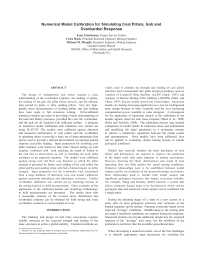Mining Publication: Numerical Model Calibration for Simulating Coal Pillars, Gob and Overburden Response
Original creation date: July 2010
The design of underground coal mines requires a clear understanding of the overburden response, the loading of pillars, the loading of the gob, the pillar failure process, and the ultimate load carried by partly or fully yielding pillars. Very few high-quality stress measurements of yielding pillars and gob loading have been made in full extraction mining. Well-calibrated numerical models can assist in providing a better understanding of the load and failure processes, provided the coal, the overburden, and the gob are all modeled with sufficient realism. A program of numerical model calibration and validation was carried out using FLAC3D. The models were calibrated against observed and measured performance of coal pillars and the overburden in operating mines to provide a basic set of input parameters that can be used to provide a realistic first estimate of expected ground response and pillar loading. Input parameters for modeling coal pillar response were based on data from triaxial testing on coal samples, combined with both matching the depth of failure in the coal ribs to observations as well as matching the peak pillar resistance to an empirical equation. The models were calibrated against strong roof and floor case histories in which the pillar strength is governed by failure and yielding of the coal within the pillar and the surrounding strata only had a limited impact on pillar strength. Input parameters for the overburden were determined from a large database of laboratory tests and model calibration against maximum subsidence and subsidence curvature. Further overburden calibration was carried out by matching stresses in the mining horizon to field measurements. Three examples of the application of the calibrated dataset and modeling methodology to field measurements are presented. The results show that a reasonable estimate of the in-seam stress distribution and overburden response can be obtained for both strong and weak overburden scenarios at various depths of cover.
Authors: GS Esterhuizen, C Mark, MM Murphy
Conference Paper - July 2010
NIOSHTIC2 Number: 20037622
Proceedings of the 29th International Conference on Ground Control in Mining, Morgantown, West Virginia, July 27-29, 2010. Barczak T, ed., Morgantown, WV: West Virginia University, 2010; :46-57
See Also
- Calibration and Verification of Longwall Stress Models
- Critical Review of Numerical Stress Analysis Tools for Deep Coal Longwall Panels Under Strong Strata
- Determination of In Situ Deformation Modulus for Cemented Rockfill
- Initial Stability Study of Large Openings for the National Underground Science Laboratory at the Homestake Mine, Lead, SD
- Numerical Modeling Procedures for Practical Coal Mine Design
- Proceedings: New Technology for Ground Control in Multiple-seam Mining
- Rock Falls
- Roof Support
- The State-of-the-Art in Coal Pillar Design
- Technology News 526 - Proceedings of the International Workshop on Rock Mass Classification in Underground Mining
- Using Site Case Histories of Multiple Seam Coal Mining to Advance Mine Design
- Page last reviewed: 9/21/2012
- Page last updated: 9/21/2012
- Content source: National Institute for Occupational Safety and Health, Mining Program


 ShareCompartir
ShareCompartir
